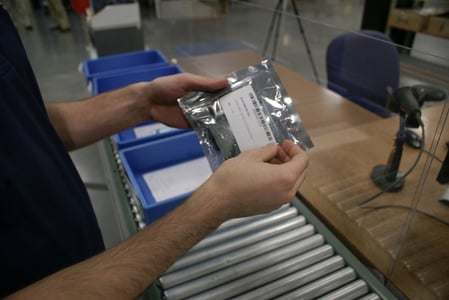2024

Increase Your Order Accuracy, Increase Your Profits
Woe is the picking error. The bane of the fulfillment manager’s existence. The cause of nearly $390,000 in losses to the average distribution center’s annual bottom line. The reason I’m writing this post.
Look, picking errors happen, I get it. Pickers are, after all, only human. But with an estimated 35% of fulfillment operations suffering from ongoing picking error rates of 1% or more, the costs add up quickly.
Ultimate Guide to Improving Order Fulfillment
Consider the cost of a picking mistake is not just the cost of the item picked in error, but also the expenses associated with shipping the item back, processing it when received and putting it back into inventory while simultaneously picking, packing and shipping the right item back to the customer—quickly. Oh, and by the way, now the customer is ticked off too (how much does THAT cost?).
It is possible, however, to kick those picking errors to the curb. Or at least dramatically minimize the chance of them happening. How? By implementing one or more of the multiple technologies available to dramatically boost picking accuracy. These systems are all proven to significantly reduce picking errors, regardless of the type of storage mode used, including static shelving, pallet rack or an automated storage and retrieval system (AS/RS) such as a horizontal or vertical carousel or a vertical lift module (VLM).
Here’s a look at five of the mispick-busting options out there, helping pickers reduce picking error rates (and improve throughput as well):
-
Labeling
It sounds really simple, but you’d be surprised at how effective integrating a labeling step into your existing receiving process can be in increasing stocking and order picking accuracy. Parts can be labeled with part number, lot number, serial number, batch number—whatever numbers are most important to you. To ensure you are sending the right part to the right person, consider bagging and tagging your parts to track the inventory throughout its lifecycle, and help you process returns faster and easier.

-
Radio-Frequency (RF) Barcode Scanners
Using a hand-held scanner to read barcode labels quickly and accurately confirms the right product has been picked. This eliminates the time needed to read the labels, and boosts warehouse picking accuracy (and speed) with a quick scan.

-
Light-Directed Picking
There are several variations of pick-by-light technologies out there, read more here. But briefly, these systems use modules to display one or more combinations of blinking colored lights, alphanumeric displays and projected beams to show a picker exactly where the next needed item is stored, its SKU number and quantity to pick. By taking the guesswork and the search time out of picking or placing an item, lights eliminate picking errors—often boosting warehouse picking accuracy rates to 99% or higher.

-
Counting by Scale
Ideal for small parts, identical in weight, the scales are pre-programmed to identify quantity based on total part weight. For operations handling hundreds of tiny pieces, like nuts and bolts, counting by scale is a very effective way to increase both picking accuracy and productivity.
-
Picture Database
It’s way easier to identify items by looking at a photo instead of a line item with a ridiculously long part number and a difficult to decipher part name. With a database of photos taken of each SKU in inventory and connected to order management software, a picker has a visual reference right next to them on a display, or in-hand on a scanner. Then, the picked item can be compared to the image on screen, reducing order picking error rates.
By the way, each of these technologies doesn’t have to work alone. In fact, most are implemented together within the same operation or storage system for even higher picking accuracy gains overall.
For example, scanning a barcode on a pick list often triggers light-directed picking systems to illuminate in front of required items, or prompt an image of the required item to appear on screen. Counting by scale is handy when bagging and tagging parts into batches for individual labeling. Or pick-to-light might be used in forward pick zones and barcode scanners in reserve storage. The possibilities for better order picking accuracy are virtually unlimited.


